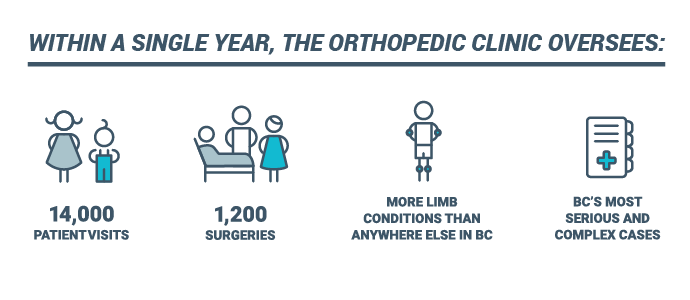Changing the future of pediatric orthopedic care—and of our children
A decade ago, if children tore or sprained their anterior cruciate ligament (ACL)—one of the key ligaments in the knee—they would either have to stop sports or wait until they stopped growing before getting it reconstructed. This could take years and would impact any aspects of their daily lives. Fast forward to today, and surgeons at BC Children’s can now safely reconstruct a child’s ACL while they’re growing—allowing them to get back to their favourite activities sooner than ever before.
That’s just one of many examples of the remarkable progress in pediatric orthopedics.
While torn ligaments and broken bones often spring to mind when most think of orthopedics, at BC Children’s, it means so much more. The hospital’s orthopedic clinic sees hundreds of different types of conditions, ranging from serious spine and limb deformities to traumatic injuries. It’s one of the busiest clinics in the province, with over 14,000 visits from patients each year.
Across Canada and around the world, the clinic’s seven orthopedic surgeons are known as global leaders, pioneering new advances in many areas of clinical care and research.
For instance, Dr. Kishore Mulpuri, a pediatric orthopedic surgeon at BC Children’s, spearheaded a screening program for kids with cerebral palsy that reduced the number of hip dislocations among these patients in BC from 15 to 20 each year down to zero—in just a few years.
In addition, the limb lengthening practice, led by pediatric orthopedic surgeon Dr. Anthony Cooper, was the first in Canada to use a non-invasive surgical technique for older children that lengthens the bone using electromagnetic technology. It has kids walking without support immediately, as opposed to the current recovery time: six months on crutches.
In these areas and others, like complex spine conditions and knee injuries, kids are getting back to walking, running and playing much more quickly than they would have otherwise. But for every life that is transformed, more kids still hope for a day when they will be freed of their limitations as they grow into adulthood.
Orthopedic experts at BC Children’s are leading advances that will do exactly that. Beyond solving the problem at hand, they weigh decisions on each child’s treatment through the lens of their entire future.
“When you’re treating a young child you not only see them as an eight-year-old, but also as a 30-year-old, a 50-year-old,” said Dr. Christopher Reilly, head of the department of orthopedics at BC Children’s. “And when you design their treatment, you also have to think about the long term, because the effects are permanent.”

This is where research comes in. To determine the best therapies with a child’s entire lifetime in mind, experts conduct what’s called clinical outcomes research.
“It’s not research done in a petri dish or in a lab,” explained Dr. Reilly. “It’s research that’s done in our clinic every day with the children that we treat. They partner with us every time they come, year after year, to define the outcomes.”
Until now, one critical piece of this plan had been missing: dedicated resources and people to ensure that research can continue for years to come. That’s why the team needs a comprehensive clinical outcomes research program that will help expand and continue this research.
“Our vision is to develop a legacy, a structure, where every child’s treatment influences the treatment of future children.” —Dr. Christopher Reilly
This has been no small task. For years, orthopedic surgeons managed to pursue groundbreaking research in their areas, while also carrying a full clinical and surgical load. But to establish a formalized clinical research program, BC Children’s Hospital Foundation is enlisting the help of supporters to make it happen.
The impact of this funding on the future of clinical outcomes research at BC Children’s will be enormous for kids and families across the province and around the world. “We’re just getting started,” said Dr. Mulpuri. “The support of donors will allow us to take on greater challenges and solve more problems that will transform lives.”

